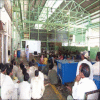Workplace tobacco cessation program in India: A success story
- PMID: 20442834
- PMCID: PMC2862448
- DOI: 10.4103/0019-5278.58919
Workplace tobacco cessation program in India: A success story
Abstract
Context: This paper describes the follow-up interventions and results of the work place tobacco cessation study.
Aims: To assess the tobacco quit rates among employees, through self report history, and validate it with rapid urine cotinine test; compare post-intervention KAP regarding tobacco consumption with the pre-intervention responses and assess the tobacco consumption pattern among contract employees and provide assistance to encourage quitting.
Settings and design: This is a cohort study implemented in a chemical industry in rural Maharashtra, India.
Materials and methods: All employees (104) were interviewed and screened for oral neoplasia. Active intervention in the form of awareness lectures, focus group discussions and if needed, pharmacotherapy was offered. Medical staff from the industrial medical unit and from a local referral hospital was trained. Awareness programs were arranged for the family members and contract employees.
Statistical analysis used: Non-parametric statistical techniques and kappa.
Results: Forty eight per cent employees consumed tobacco. The tobacco quit rates increased with each follow-up intervention session and reached 40% at the end of one year. There was 96% agreement between self report tobacco history and results of rapid urine cotinine test. The post-intervention KAP showed considerable improvement over the pre-intervention KAP. 56% of contract employees used tobacco and 55% among them had oral pre-cancerous lesions.
Conclusions: A positive atmosphere towards tobacco quitting and positive peer pressure assisting each other in tobacco cessation was remarkably noted on the entire industrial campus. A comprehensive model workplace tobacco cessation program has been established, which can be replicated elsewhere.
Keywords: Contract employees; focus group discussions; tobacco cessation; urine cotinine; workplace.
Conflict of interest statement
Figures




Similar articles
-
Factors Influencing Implementation of a Workplace Tobacco Cessation Intervention in India: A Qualitative Exploration.Workplace Health Saf. 2021 Feb;69(2):56-67. doi: 10.1177/2165079920952761. Epub 2020 Dec 13. Workplace Health Saf. 2021. PMID: 33308086 Free PMC article.
-
Establishing a model workplace tobacco cessation program in India.Indian J Occup Environ Med. 2009 Aug;13(2):97-103. doi: 10.4103/0019-5278.55129. Indian J Occup Environ Med. 2009. PMID: 20386628 Free PMC article.
-
Oral Cancer Screening at Workplace in India-One-year Follow-up.Indian J Community Med. 2011 Apr;36(2):133-8. doi: 10.4103/0970-0218.84133. Indian J Community Med. 2011. PMID: 21976799 Free PMC article.
-
A Pilot Clinical Trial of Smoking Cessation Services Implemented in the Workplace for Service Industry Employees.Am J Health Promot. 2019 May;33(4):516-524. doi: 10.1177/0890117118795987. Epub 2018 Aug 28. Am J Health Promot. 2019. PMID: 30153737 Free PMC article. Clinical Trial.
-
The Economic Impact of Smoking and of Reducing Smoking Prevalence: Review of Evidence.Tob Use Insights. 2015 Jul 14;8:1-35. doi: 10.4137/TUI.S15628. eCollection 2015. Tob Use Insights. 2015. PMID: 26242225 Free PMC article. Review.
Cited by
-
Prevalence of Oral Potentially Malignant Lesions, Tobacco use, and Effect of Cessation Strategies among Solid Waste Management workers in Northern India: a pre-post intervention study.BMC Oral Health. 2024 Oct 26;24(1):1292. doi: 10.1186/s12903-024-05087-8. BMC Oral Health. 2024. PMID: 39462398 Free PMC article. Clinical Trial.
-
Evaluation of research on interventions aligned to WHO 'Best Buys' for NCDs in low-income and lower-middle-income countries: a systematic review from 1990 to 2015.BMJ Glob Health. 2018 Feb 19;3(1):e000535. doi: 10.1136/bmjgh-2017-000535. eCollection 2018. BMJ Glob Health. 2018. PMID: 29527342 Free PMC article.
-
An overview of the tobacco problem in India.Indian J Med Paediatr Oncol. 2012 Jul;33(3):139-45. doi: 10.4103/0971-5851.103139. Indian J Med Paediatr Oncol. 2012. PMID: 23248419 Free PMC article.
-
Factors Influencing Implementation of a Workplace Tobacco Cessation Intervention in India: A Qualitative Exploration.Workplace Health Saf. 2021 Feb;69(2):56-67. doi: 10.1177/2165079920952761. Epub 2020 Dec 13. Workplace Health Saf. 2021. PMID: 33308086 Free PMC article.
-
Experiences recruiting Indian worksites for an integrated health protection and health promotion randomized control trial in Maharashtra, India.Health Educ Res. 2015 Jun;30(3):412-21. doi: 10.1093/her/cyv010. Epub 2015 Mar 21. Health Educ Res. 2015. PMID: 25796269 Free PMC article. Clinical Trial.
References
-
- Bhonsle RB, Murti PR, Gupta PC. Tobacco habits in India. In: Gupta PC, Hamner JE, Murty PR, editors. Control of tobacco-related cancers and other diseases. Proceedings of an International Symposium, 15-19 January 1990. Mumbai: TIFR, Oxford University Press; 1992. pp. 25–46.
-
- Kishore J. National Health Programs of India. 5th ed. 2005. National Cancer Control Program; p. 239.
-
- Fiore MC, Bailey WC, Cohen SJ, Dorfman SF, Goldstein MG, Gritz FR. Treating tobacco use and dependence: Clinical practice guideline. Rockville, MD: US Department of Health and Human Services, Public Health Service; 2000.
-
- Hughes JR, Gulliver SB, Fenwick JW, Valliere WA, Cruser K, Pepper S, et al. Smoking cessation among self-quitters. Health Psychol. 1992;11:331–4. - PubMed

